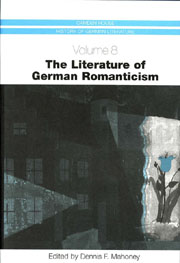Book contents
- Frontmatter
- Contents
- Illustrations
- Acknowledgments
- Abbreviations
- Introduction
- From “Romantick” To “Romantic”: The Genesis of German Romanticism in Late Eighteenth-Century Europe
- Goethe and the Romantic
- Early Romanticism
- From Goethe's Wilhelm Meister to anti-Meister Novels: The Romantic Novel between Tieck's William Lovell and Hoffmann's Kater Murr
- Tales of Wonder and Terror: Short Prose of the German Romantics
- The Romantic Drama: Tieck, Brentano, Arnim, Fouqué, and Eichendorff
- German Romantic Poetry in Theory and Practice: The Schlegel Brothers, Schelling, Tieck, Novalis, Eichendorff, Brentano, and Heine
- The Turn to History and the Volk: Brentano, Arnim, and the Grimm Brothers
- History and Moral Imperatives: The Contradictions of Political Romanticism
- Romanticism and Natural Science
- Gender Studies and Romanticism
- The Romantic Preoccupation with Musical Meaning
- Romanticism and the Visual Arts
- Goethe's Late Verse
- The Reception of German Romanticism in the Twentieth Century
- Works Cited
- Notes on the Contributors
- Index
Tales of Wonder and Terror: Short Prose of the German Romantics
Published online by Cambridge University Press: 05 February 2013
- Frontmatter
- Contents
- Illustrations
- Acknowledgments
- Abbreviations
- Introduction
- From “Romantick” To “Romantic”: The Genesis of German Romanticism in Late Eighteenth-Century Europe
- Goethe and the Romantic
- Early Romanticism
- From Goethe's Wilhelm Meister to anti-Meister Novels: The Romantic Novel between Tieck's William Lovell and Hoffmann's Kater Murr
- Tales of Wonder and Terror: Short Prose of the German Romantics
- The Romantic Drama: Tieck, Brentano, Arnim, Fouqué, and Eichendorff
- German Romantic Poetry in Theory and Practice: The Schlegel Brothers, Schelling, Tieck, Novalis, Eichendorff, Brentano, and Heine
- The Turn to History and the Volk: Brentano, Arnim, and the Grimm Brothers
- History and Moral Imperatives: The Contradictions of Political Romanticism
- Romanticism and Natural Science
- Gender Studies and Romanticism
- The Romantic Preoccupation with Musical Meaning
- Romanticism and the Visual Arts
- Goethe's Late Verse
- The Reception of German Romanticism in the Twentieth Century
- Works Cited
- Notes on the Contributors
- Index
Summary
Novellas and tales – like the novels and lyrical poetry of German Romanticism – are an essential part of the Romantic legacy and can claim their well-deserved place in the pantheon of German literature. They have never fallen out of favor with the reading public and even today capture our imagination. Undoubtedly this ongoing fascination is in no small part due to the depiction of strange and terrifying events in Romantic novellas and artistic fairy tales that unearth the darker side of the human soul. Indeed, for today's readers who receive an almost daily dose of the supernatural via television and motion pictures, the wondrous occurrences in these texts could have come straight from the twilight zone of the X-Files: a knight loses his sanity and life when he finds out that his marriage is based on an incestuous relationship; young men succumb to the seductive powers of marble statues and female automatons; protagonists make deals with evil forces and trade their shadows and hearts for material wealth; a woman seemingly experiences immaculate conception; and a mentally disturbed soldier single-handedly terrorizes a whole city. Yet in the Romantic imagination, these extraordinary events not only satisfy the curiosity of readers who desire to transcend the experiences of everyday life, but also represent narrative points of departure for the creative fusion of the rational with the irrational, the outer with the inner world, and the profane with the sublime.
- Type
- Chapter
- Information
- The Literature of German Romanticism , pp. 101 - 124Publisher: Boydell & BrewerPrint publication year: 2003

